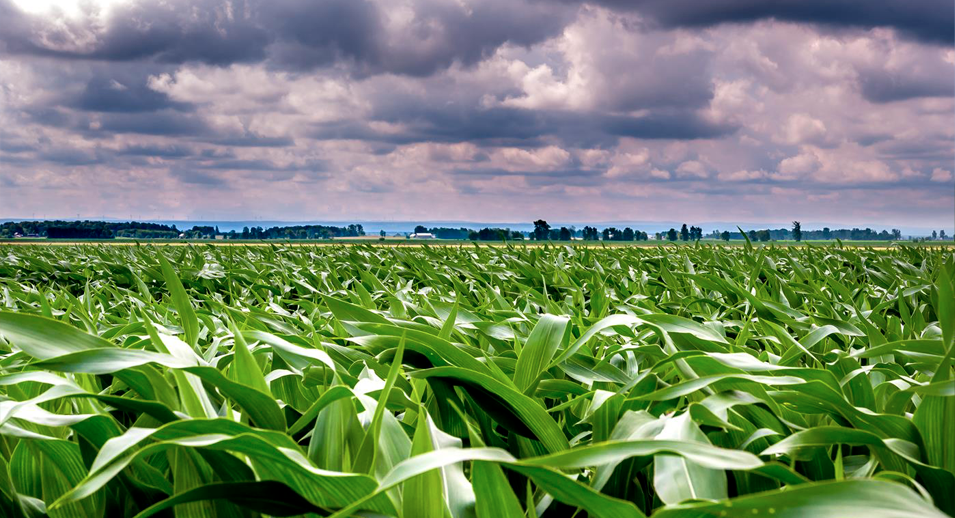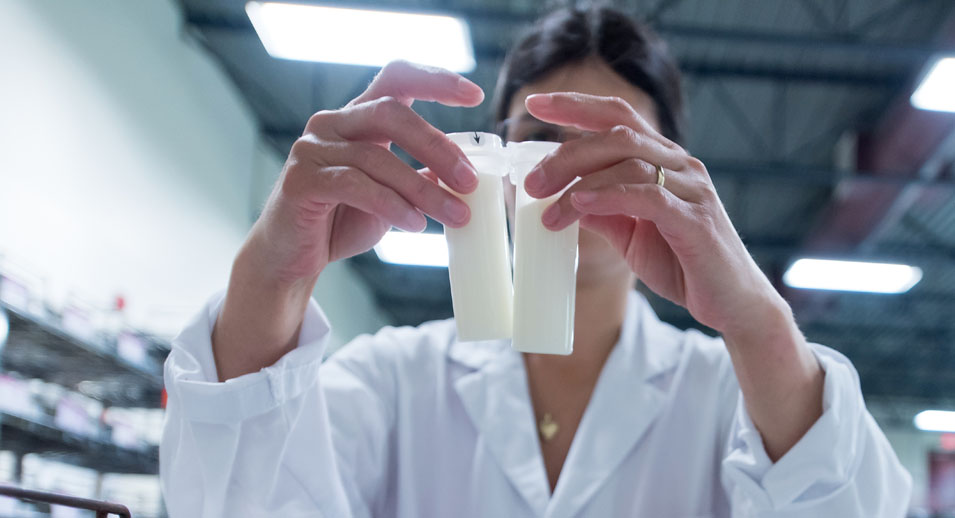Nine Common Questions about Harvesting Corn Silage
- September 13, 2019
Corn silage is an important food for many dairy herds, making every detail from the field to the feed bunk significant. The harvest period is almost here and to help you get ready, here are nine common questions (and answers!) about harvesting corn silage.

1. What is the best time to harvest corn silage?
The ideal dry matter (DM) for harvesting corn silage is between 32-40%. This recommendation will vary according to how the silage is stored (tower silo, stack silo, bunker silo). Recommendations for tower silos will depend on the height and diameter of your silo (see page 10, Silage Interpretation Guide, in french only). Corn silage that has a DM below 30 % will result in a loss of DM and nutrients from leaching due to seepage. Whereas silage that has been harvested with a DM above 40% will have reduced fibre and starch digestibility and result in compaction problems.
2. What is the ideal cutting height for corn plants?
Since BMR corn silage has been found to be superior from a nutritional point of view, even at a high cutting height1, this question only applies to conventional corn varieties (not BMR).
The first point to consider is: “will I run out of silage if I cut the corn higher (19 inches)”? If the answer is yes, it is recommended that you keep the cutting height between 6 and 9 inches. If the answer is no, although cutting your corn silage at a higher height will decrease the yield per hectare, it will allow you to:
- harvest several days earlier;
- improve nutritional value;
- use more corn silage in the ration and therefore use less concentrates;
- increase milk production (when the ration is adjusted to maintain or increase daily fat production).
Cutting height is one factor among others that can help you improve corn silage quality. For more information talk to your Lactanet advisor*.
3. Are kernel processors important?
The use of kernel processors will improve starch digestibility if the DM at harvest is higher than 32 % DM2. Otherwise, there is a risk of losing nutrients to leaching. It is important to adjust kernel processors before harvesting to ensure that the grains are well cracked, ideally in four. Table 1 shows the optimal space according to DM and theoretical silage chop length. In the absence of kernel processors, the recommendation is to aim for a chop length of 3/8 inch or sometimes even less depending on the maturity of the grain at harvest.
|
Silage Dry Matter (% DM) |
Theoretical Chop Length (inches) |
Space between rollers (mm) |
| Less than 32 % |
3/4 |
3-4 |
| 33-40 % |
3/4 |
2-3 (Hard Grain) |
| 33-40 % |
1/2 |
3-4 (Soft Grain) |
| More than 40 % |
3/8 |
1-2 (Hard Grain) |
| More than 40 % |
3/8 |
2-3 (Soft Grain) |
4. What is the ideal corn silage chop length?
According to Table 1 above, a ¾-inch chop length is recommended when the corn silage harvest falls within the optimal DM of 34-40 %. Above 40 %, the recommendation is to reduce the theoretical chop length to 3/8 inch in order to minimize the negative effects that a more mature corn silage can have on the digestibility of NDF fibre and feed intake. The best way to validate the theoretical chop length is to ask your Lactanet advisor* to perform a Penn State test on your freshly harvested corn silage.
5. What should I do if my corn freezes before harvest?
If your corn has been exposed to a killing frost at an immature stage (less than 30% DM), it should not be harvested right away, as there will be significant dry matter and nutrient losses in storage due to leaching. It is important to wait until the plants reach a DM above 33%, to ensure proper fermentation. Depending on the conditions, just a few days may be enough time to reach the proper conditions.
Brown leaves on a corn plant are not a good indicator of moisture levels, since most of the moisture is found in the stalk and the grain. It is important to use the harvester to evaluate moisture levels. Note that a frozen corn plant will dry more slowly than a live corn plant. The same storage techniques are recommended as those for corn that has not been frozen, but it should be stored separately.
6. Should I use an inoculant on my corn silage?
Our article “Update on the Use of Silage Inoculants“, taken and adapted from Choosing an Effective Silage Inoculant by Limin Kung, Jr., will help you to make an informed decision that is right for your situation.
Another question to ask yourself is: « should I use an inoculant that only has a heterofermentative strain or a combination of heterofermentative and homofermentative strains (Combo) » ?
There are no clear answers to this question in the scientific literature at this time because the response to the use of a combination is variable, in both fermentation quality and animal response.
We do know, however, that the use of homolactic bacteria combined with heterofermentative bacteria will accelerate the drop in pH, inhibit the development of enterobacteria and clostridium, as weel as reduce proteolysis and loss of dry matter.
Homolactic bacteria are less expensive than heterofermentative, so the use of homolactic bacteria will have a significant influence on the final cost of the feed. This is not the case for economic losses due to poor dry matter levels, compaction, silo sealing and feed recovery.
7. Is my bunker or stack silo properly compacted?
Ideal silage compaction on a DM basis should reach a density of 15 lbs/cubic foot or 240 kg/ cubic metre of DM. For tower silos, this density can be reached by following DM recommendations, which vary according to the type and dimensions of the silo as well as chop length.
As for bunker or stack silos, although the DM and theoretical chop length are important, the two most essential factors for obtaining the desired density is the weight used to compact the silage (varies according to the unloading speed) and DM at harvest. Researchers at the University of Wisconsin have developed a practical calculation, which is helpful for evaluating whether your compaction meets your objectives.
8. Will adding an oxygen barrier really improve the quality of my silage?
According to a meta-analysis3, the use of an oxygen barrier, as compared to the standard membrane used for bunker and stack silos, will:
- reduce DM losses on the outside layer (10 to 60 cm) from 19,5 % to 11,4 % DM;
- reduce the non-consumable portion from 10,7 % to 2,96 %;
- improve aerobic stability from 75.3 h to 134.5 h.
9. What should I do if I have to feed unfermented corn silage to my cows?
If the circumstances on your farm will not allow you to let your corn silage ferment for at least 3 to 4 weeks before feeding it to your cows, here are some tips to follow:
- Not more than 15% of the DM in the ration should come from unfermented corn silage;
- Be mindful of the risk of acidosis, because the rapidly fermentable sugars that are usually used up by silage fermentation will be ingested by the animal:
- add products that will buffer the rumen pH directly to the ration or by free choice;
- reduce the supply of rapidly fermentable sugars such as molasses, high moisture corn and other by-products;
- increase effective fibre in the ration.
- Be sure to meet the animal’s soluble protein needs. In the absence of fermentation, proteins are not solubilized which reduces the concentration of soluble protein in the non-fermented silage as compared to fermented silage;
- Feed only corn silage that is freshly removed from the silo; never leave it in a feed cart during the day or night.
1 https://www.journalofdairyscience.org/article/S0022-0302(08)71273-6/fulltext
2 Ferraretto, L. F. et R. D. Shaver. 2012. Meta-analysis: Effect of corn silage harvest practices on intake, digestion, and milk production by dairy cows. The Professional Animal Scientist 28(2):141-149. doi:10.15232/s1080-7446(15)30334-x
3 https://onlinelibrary.wiley.com/doi/abs/10.1111/gfs.12087
*Services offered may differ depending on the region and may not be available across Canada at this time. Please contact our Customer Service should you have any questions.











